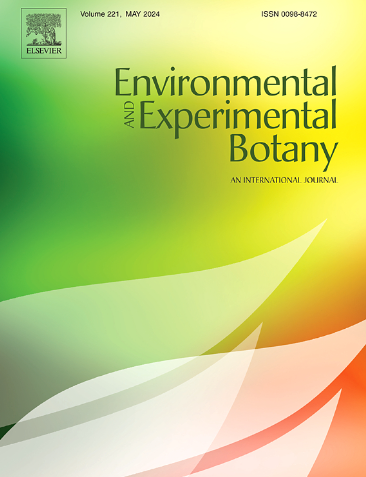Integrative transcriptomic and metabolomic analyses reveal crucial roles of phenylpropanoid-derived coumarin biosynthesis in the responses of peanut to iron deficiency
IF 4.7
2区 生物学
Q2 ENVIRONMENTAL SCIENCES
引用次数: 0
Abstract
Iron (Fe) deficiency severely limits peanut productivity, particularly in calcareous soils. This study integrated transcriptomic and metabolomic analyses to elucidate molecular mechanisms underlying Fe-deficiency responses in two peanut cultivars: Silihong (Fe-efficient) and Fenghua 1 (Fe-inefficient). Under Fe deficiency, both cultivars exhibited leaf chlorosis and reduced chlorophyll content, with Fenghua 1 showing greater sensitivity. Fe deficiency triggered extensive metabolic reprogramming, preferentially enhancing phenylpropanoid-derived coumarin biosynthesis while suppressing lignin and flavonoid pathways. Key genes, including PAL1, 4CL1, CCoAOMT, CSE, CYP98A2, HCT, F6′H1, S8H, and CYP82C4, were upregulated, promoting the accumulation of Fe-mobilizing coumarins (scopoletin, fraxetin, esculetin). The efficient cultivar Silihong displayed stronger induction of coumarin synthesis genes, higher coumarin exudation, and greater suppression of competing pathways than Fenghua 1. Weighted gene co-expression network analysis identified hub genes (FIT, MYB72, IRT1, and FRO2) co-expressed with coumarin biosynthesis genes (CCoAOMT, F6′H1, S8H, and CYP82C4), suggesting an evolutionarily conserved FIT–MYB72 regulatory module for Fe acquisition. Additionally, PDR3 homologs implicated in coumarin secretion were significantly induced. These findings highlight coumarin-mediated Fe mobilization as a critical adaptive strategy in peanuts and provide genetic targets for breeding Fe-efficient cultivars.
综合转录组学和代谢组学分析揭示了苯丙素衍生香豆素生物合成在花生对铁缺乏的反应中的重要作用
铁(Fe)缺乏严重限制了花生的产量,特别是在钙质土壤中。本研究结合转录组学和代谢组学分析,阐明了两个花生品种四里红(铁高效)和丰化1号(铁低效)铁缺乏反应的分子机制。缺铁条件下,2个品种均表现出叶片萎黄和叶绿素含量降低的现象,其中丰化1号表现出更强的敏感性。缺铁触发了广泛的代谢重编程,优先促进苯丙素衍生的香豆素生物合成,同时抑制木质素和类黄酮途径。关键基因PAL1、4CL1、CCoAOMT、CSE、CYP98A2、HCT、F6'H1、S8H、CYP82C4上调,促进了铁动员香豆素(东scopetin、fraxetin、esculletin)的积累。与丰化1号相比,高效品种四里红对香豆素合成基因的诱导作用更强,香豆素分泌量更高,对竞争途径的抑制作用更强。加权基因共表达网络分析发现枢纽基因(FIT、MYB72、IRT1和FRO2)与香豆素生物合成基因(CCoAOMT、F6'H1、S8H和CYP82C4)共表达,提示进化保守的FIT - MYB72铁获取调控模块。此外,与香豆素分泌有关的PDR3同源物也被显著诱导。这些发现强调了香豆素介导的铁动员是花生的关键适应性策略,并为培育铁高效品种提供了遗传靶点。
本文章由计算机程序翻译,如有差异,请以英文原文为准。
求助全文
约1分钟内获得全文
求助全文
来源期刊

Environmental and Experimental Botany
环境科学-环境科学
CiteScore
9.30
自引率
5.30%
发文量
342
审稿时长
26 days
期刊介绍:
Environmental and Experimental Botany (EEB) publishes research papers on the physical, chemical, biological, molecular mechanisms and processes involved in the responses of plants to their environment.
In addition to research papers, the journal includes review articles. Submission is in agreement with the Editors-in-Chief.
The Journal also publishes special issues which are built by invited guest editors and are related to the main themes of EEB.
The areas covered by the Journal include:
(1) Responses of plants to heavy metals and pollutants
(2) Plant/water interactions (salinity, drought, flooding)
(3) Responses of plants to radiations ranging from UV-B to infrared
(4) Plant/atmosphere relations (ozone, CO2 , temperature)
(5) Global change impacts on plant ecophysiology
(6) Biotic interactions involving environmental factors.
 求助内容:
求助内容: 应助结果提醒方式:
应助结果提醒方式:


